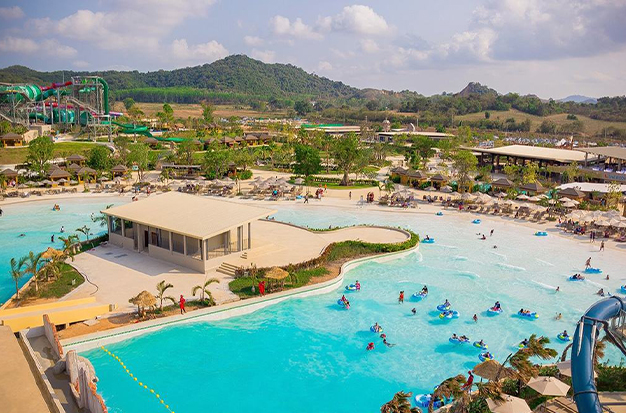How Do Wave Pools Work?
How do wave pools work? One of mankind’s oddest re-creations of nature is the artificial ocean shore, also known as the wave pool. These well-liked water park attractions are sanitized, controlled reinterpretations of the organic, wild surfs produced by nature. In wave pools, the water is chlorinated, the beach is made of concrete, and the waves come in a regular, 15-20 minute interval.
Even though the water is chlorinated and the beach is made of concrete, what happens to the water is what matters. Waves appear as if by clockwork.
These are perfect for both experienced board riders who want to have a little fun and beginning surfers who want to learn new skills. And how do they produce waves, though?
Let’s examine the operation of wave pools. We’ll learn about the advanced and potent technology that keeps these waves shifting constantly.
Wave Pools: How Do They Work?
Let’s first examine how ocean waves are produced. The wind creates the violent waves that appear to be calling out for carving and cutbacks.
At specific locations, rushing air causes water molecules to group together and swell. The molecules next to them are then pushed by these molecules in a chain (resembling a Mexican wave).
As a result, the water surface disturbance is propagated while the individual water molecules stay in the same region.
Replicating this kind of water reaction can be done in a number of ways. A basin of water and a method for creating a constant or recurring disturbance on the water’s surface are all that are required.
For example, a rotating paddle wheel like those found on steamboats or watermills, an oscillating plunger, or a strong blast of air rushing along the surface can all be used to accomplish this.
The energy will spread out and touch the water in the vicinity as long as you can exert pressure on the water at a specific location. Put a rock into a body of water in your mind. You can see tiny waves moving away from the rock in the ripples you see.
Man-Made Wave Pools
To simulate ocean waves, various types of machines are used. We discuss the five main categories of technology below.
- Air compression technology – Utilizing pressure and vacuum inside a specially made concrete chamber, this type of wave generation technology generates wind. A swell is then produced when this pressure is forced through an opening at the bottom of each chamber and released into open water. It is possible to produce almost any type of wave by firing these air compression “jets” in a specific order.
- Hydrofoil Technology – Galvanized steel blades are used in hydrofoil wave pools, which pull them down the side or in the center of a body of water along a track under water using a gearless drive system. The submerged foil pushes out a wake that forms a wave when it is pulled, which moves the water.
- Lever technology – With this technology, waves are pushed out by tiny levers that fire off inside a module. You can even produce waves of various sizes and shapes. In order to do this, you would use the software that operates the levers; from there, you could change the wave’s size, frequency, shape, and power.
- Plunger technology – Technically, compressed air drives the lever that lowers the plunger and causes the waves to be sent out in rings. The least prevalent technology is this one, and it’s typically used in places where it’s impossible to construct swimming pools. Instead, they are constructed inside of lakes. These lakes’ bottoms are made with specific breaks on each side for various waves and conditions as the wave diffuses outward from the center.
- Water dumping technology – Pumping water into a reservoir tank, then suddenly dumping it into the main pool when the tank is full is known as water dumping. A wave is produced as a result of this force moving the water. Although the method of dumping water doesn’t have as much precise control over the size and shape of waves, dumping more water does make waves bigger and stronger.
Five Basic Components In A Wave Pool
- The water pumping system
- The water collection reservoir
- A vast swimming pool with a slanted design
- Numerous release valves located at the bottom of the water collection reservoir
- The return canal that generally leads from the beach to the pumping station
The fact that no two wave pools are exactly alike should not be overlooked. Different wave patterns, such as:
- Line waves
- Mixed waves
- Left-sided waves
- Right-sided waves
Line waves are typically the most frequently used, though the strength of these waves can vary depending on the wave pool’s settings.
The length of the wave, which is equal to the width of the pool, forms parallel to the beach. These are the waves to wait for if you want to take your board into one of these pools.
Benefits Of Standing Wave Pools
– Smaller footprint, so they work in areas with space limitations
– Standard surfboard equipment can be used instead of specialized craft
– Easier entry threshold to the sport of surfing as a training bar can be deployed
– Intimate environment. Spectators are close to the action which creates a group atmosphere
– Offers variety for wave parks with traditional wave pools, adding more surf options for visitors

Wave Pools Are New?
Despite the futuristic concept, wave pool technology is not a particularly original thought.
The very first design was created in the 19th century. According to legend, Ludwig II of Bavaria rigged one of his private lakes to produce waves. The use of synthetic waves in indoor swimming pools began in 1929. Rectangular paddles encircled a swimming pool in Munich, Germany. To make ripples in the water, they used it to force the water through metal grates. It promised that there would be “no more calm waters for swimmers.””
A swimming pool in Wembley, London, would employ hydraulic technology ten years later. However, Phil Dexter did not construct the first surfable wave pool until 1969 in Tempe, Arizona.
What Different Kinds Of Wave Pool Exist?
Wave pool technology comes in a variety of forms. We’ll go through each type of pool in this article – each has its benefits and flaws, but one thing is for sure – they are all pretty darn fun!
Recreational Wave Pools
The first thing that springs to mind when your average Joe says wave pool, is this type – The wave pool for leisure. The 1980s saw the development and widespread public opening of these pools, which were the first of their kind. These wave pools do not really lend themselves to surfing because of their relatively gentle waves. Only in the extremely shallow water close to the edge of the pool do waves actually break; they usually move through the water as small “swells” instead.
The most common kind of wave pool in the world is a recreational one. They are typically part of a larger water park complex with other features like water slides. One of the most well-known recreational water parks is AquaAdventure Waterpark in Dubai, which is a water park, and World Waterpark in Canada.
Pneumatic Wave Pools
Waves that are so impressive they can be surfed can be produced using pneumatic technology. In a pneumatic system, watertight concrete chambers with air blowers are constructed at the end of the pool. By forcing the water in the chambers downward and outward when the blowers release air, waves are created. This system enables the replication of various wave patterns, some for more experienced surfers and some for beginners.
However, the pneumatic approach also ensures longevity in addition to its undeniable wave-generating abilities. Corrosion wouldn’t be a possibility because none of the components would be submerged. Since the pool no longer requires draining, it also means low maintenance costs.
In the event that a repair is necessary, the staff can easily access the system. To make finding replacements simple, pneumatic systems even have standardized machine parts. Additionally, the system can still function thanks to its multiple chamber design even when one chamber is damaged. This enables maintenance and repairs to be done without having to stop the entire operation.
Plough Wave Pools
The plow method is yet another master of wave pool technology. Some of the most well-known surf parks use the plough technique to create thrilling, leg-burning rides. A hydrofoil that is driven by a drive system makes up the mechanism. The hydrofoil typically has a wing or blade made of galvanized steel, much like an airplane. It moves along a linear track that runs down the middle or side of the pool to produce extremely powerful waves.
The waves and the blades typically move at a speed of 4.5 to 7.5 meters per second on average.
Check out the awesome Casey Neistat clip from the Kelly Slater Wave Co. below, which makes use of this plough-style technology.
The angle and shape of the plough push the water in the appropriate manner, much like snow ploughs and farmyard ploughs do. Since the plough has a fixed shape, it can always produce perfect waves; of course, this depends on the wind conditions on a given day. Because of this plough technology, the waves are incredibly reliable and predictable every time.
Water is dispersed from the plough’s hull in significant quantities as it moves. Large wakes are created by displacement, which later manifests as waves. Waves of various sizes and shapes can be produced by varying the speed and angle of the plough or foil.
With a 4-minute gap between each wave, a surfer can ride one in an average time of 45 to 60 seconds. The waves travel between 10 and 20 miles per hour and peak at a height of about 6 feet. After finishing a run, the plough will turn around and make a wave in the opposite direction, but in reverse. As a result, the plough will first make a right-hander before moving in the opposite direction to make a left-hander.
Adapted Wave Pools
These types of wave pools were created with surfing in mind but were constructed using conventional methods. The hydraulic paddle and drop tank techniques are frequently employed.
The drop tank system creates waves that can be surfed by using the pool water itself. At the far end of the pool, a tank or several tanks are positioned. Each tank has a submerged quick-open latch at the bottom.
The tanks are filled with pool water from a different reservoir in order to create waves. When the tanks are full, the latch quickly releases, emptying the entire tank into the swimming pool. The waves are produced by the force of the water falling.
The hydraulic paddle system employs substantial paddles that are joined to a hydraulic arm on one end and a hinge on the other. When the arm swings the paddles back and forth, waves are produced.
Near the paddles, the pool floor has a sharp incline that causes the waves to heighten. Unlike drop tanks, which typically have a long pause between waves because the tanks must be refilled with water, the paddles can produce reliable, continuous waves.
Conclusion
One of the many modern innovations that mimics something natural is wave pools. These pools offer a wide range of recreational opportunities, including surfing.
The kind of waves you experience most depends on the wave pool’s systems, despite the fact that every wave pool has a unique shape, design, and method of producing waves.
Some may not be strong enough or suitable for surfing, but those that are can help you advance your surfing abilities significantly.
